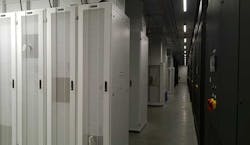NEW YORK – Data center space is leasing like never before, prompting a building boom for developers of wholesale plug-n-play space. In some markets data center companies are leasing facilities before they are even built.
Is this the new reality as data centers become the focal point of a cloud-centric world? Or is this burst of leasing a “cloud bubble” that could lead to overconfidence, and ultimately, to overbuilding?
In recent weeks, these questions have been addressed by data center executives in conference panels and earnings calls. The strong consensus is that the current data center boom has staying power, supported by the growth of cloud platforms and new data-intensive technologies.
Is the current boom too good to be true? Some analysts have expressed concern about the volume of new construction, wondering if the flurry of leasing could lead to a repeat of 2013, when pricing softened in several markets due to excess supply.
But there are several key differences between the current activity and the environment in 2013, when demand was slower and market dynamics were skewed by tenants seeking to sublease space. Perhaps most importantly, data center service providers are reducing their risk by pre-leasing space or tying construction plans to expansions by existing tenants.
“Insatiable” Demand
Jeffries analyst John Petersen says he is seeing “insatiable levels of demand” for data center space. The supply of data center space has grown 20 percent a year, he said, while vacancy rates have fallen. The demand is being driven by cloud, mobile, video and BigData. On the horizon are two potential technologies that could create significant demand for data center space: The Internet of Things and virtual reality.
On the provider side, this is being reflected in huge deals:
- DuPont Fabros Technology (DFT) has leased nearly 60 megawatts of wholesale space over the past two quarters, and 78 megawatts over the past year (compared to a historic average of about 30 MW a year)
- CyrusOne reportedly leased 30 megawatts of space to Microsoft, including 22 megawatts in Virginia and another 9 megawatts in San Antonio.
- QTS Realty has leased 8 megawatts of space in Dallas to a major hyperscale computing provider.
- Digital Realty leased the entire multi-megawatt first phase of a new project in Osaka, Japan to a large cloud provider.
The new CyrusOne data center in San Antonio, where it has reportedly signed a large lease with Microsoft. (Photo: Rich Miller)
“There is a tremendous amount of demand for our product,” said Chris Eldredge, CEO of DuPont Fabros Technology (DFT). “We are in the very early stages of cloud right now. I’d say we’re in the first inning, so demand is going to be healthy over the coming years. With the growth of the cloud and continuing outsourcing, we’re very positive and bullish on our future.”
“We are seeing deals come to us at a really quick pace, and the size of the deals are increasing,” said CyrusOne CEO Gary Wojtaszek. “We don’t know how long that will continue to last for us, but we continue to be really bullish on the opportunity in front of us.”
The Cloud Arms Race
What’s creating all this demand? The cloud computing arms race is accelerating, and the battle will be waged with data centers. The leading players are moving quickly to amass capacity for the clouds to come, resulting in huge deals for data center space under development.
Amazon Web Services has built a dominant position in the cloud computing business, with revenue approaching $10 billion a year. Cloud computing is also a priority for Microsoft and Google, who have the resources to play at huge scale. Google has accelerated its data center growth plan, while Microsoft has signed large leases.
“They’re all trying to play catch-up to AWS, and the only way to do that is to lease wholesale space,” said Jim Kerrigan, managing director at North American Data Centers. “I don’t think any of these companies are going to stop building their own data centers. But right now they need to catch up.”
Microsoft boosted its data center spending by 65 percent in the first quarter, the company said. The company said it has also abandoned its use of modular data centers (known as IT-PACs) because it needs to expand its data center capacity at a pace that can’t be achieved with the modules.
A Microsoft IT-PAC data center module at the company’s data center campus in Quincy, Washington, packed with thousands of servers. (Photo: Microsoft)
Most of the cloud leasing is focused on the data center real estate investment trusts (REITs) like Digital Realty and DuPont Fabros. One reason is that the cloud builders are seeking to lease 5 to 15 megawatts at a time, and not many companies have these large footprints available.
The Lessons of the “Field of Dreams” Era
In some ways, the industry continues to be haunted by the Ghosts of Oversupply Past. The dot-com boom created the industry’s Field of Dreams era (“Build it, and they will come”) which led to widespread vacancies and bankruptcies when the boom turned to bust in 2001-2003.
Memories of the industry’s nuclear winter prompted a shift to phased construction, with space deployed in smaller chunks to align supply with demand. Providers have been more cautious about speculative projects, seeking anchor tenants before proceeding with new builds. The use of pre-fab and modular components have shortened the lead time on new construction, easing the pressure to build ahead.
“The data center REIT management teams view ROIC (return on invested capital) as the key metric,” said Bill Stoller, who tracks the data center real estate sector. “Wall Street has forced the sector to be exceptional allocators of capital, which imposes development self-discipline. Additionally, streamlined construction methods allow for phased developments to provide just-in-time data halls.”
Data center executives affirm that the industry has grown more sophisticated in its ability to project demand and make decisions on new construction.
“I think all of us see pretty good demand,” said Tony Wanger, President of IO. “I’m quite comfortable from the metrics we track and from the markets and customers we know. I assume that these (companies building new data centers) are rational actors with good discipline and insight into their customers and demand.”
IO President Tony Wanger (right) discusses the state of the data center industry at the recent New York Data Center Summit. Listening are (from left) 1547 Realty CEO Todd Raymond and Carter Validus co-CEO Michael Seton. (Photo: Rich Miller)
“We go through a very detailed exercise,” said Steve Smith, CEO of Equinix, in describing the company’s expansion criteria. “We’re looking five years out. We’re looking across markets and (data centers) to make sure we understand what our fill rates are, what the empirical data is telling us, and what that means against our future expectations, understanding what competitive landscapes like in each of those markets.”
The wildcard in the supply equation is new entrants to the market, said Wanger. The data center business is capital-intensive and thus has a high barrier to entry. But new players with large ambitions could disrupt the supply-demand balance in key markets.
Pre-Leasing at Historic Levels
The best way for data center service providers to manage risk is to use a build-to-suit or pre-leasing strategy, where customers are signed before construction has begun. CyrusOne is building aggressively, but already has tenant commitments for 60 percent of its planned expansion space.
“We have never before had customers that have signed up in advance for us to deliver capacity for them,” said CEO Wojtaszek. “This is a really good position for us.”
DuPont Fabros pre-leased the entire 16-megawatt third phase of its Santa Clara data center, as well as space in other markets. “With our pre-leasing, as soon as we bring it on, we lease it,” said Eldredge, the CEO at DFT. “One of the challenges for us is bringing it on quick enough. We can only move so fast.”
Other providers are basing new construction on the expansion requirements of current customers. Digital Realty says that 90 percent of its first quarter leasing came from existing tenants.
“Given the sector’s recent history, any uptick in supply bears watching carefully,” said Bill Stein, the CEO of Digital Realty. “However, current construction pipelines are generally concentrated in top-tier national markets with high visibility on demand, and pre-leasing levels are healthy. Market vacancy rates within these markets are in the single-digits, and our portfolios in these markets are north of 90 percent leased. In each case, the level of 2015 absorption represents a multiple of two times to three times the level of current supply.”
The Digital Realty data center in Osaka, Japan. The first phase of this project was recently leased by a large cloud provider. (Image: Digital Realty)
Leasing rates have also remained stable. For some of the largest providers, returns are improving in key markets. “In Santa Clara, we were able to achieve an 11.5 percent return on investment (on Phase II), compared to the 9.25 percent we achieved last year on Phase II,” said Jeff Foster, the chief financial officer of DuPont Fabros. “Pricing is picking up in Santa Clara. and we’re seeing similar pickups in Chicago and Ashburn.”
Ghosts of 2013?
All these signs point to continued strength. Some analysts, however, are concerned about whether the recent flurry of leasing will satisfy cloud builders’ needs for the foreseeable future, leaving less demand to support all the new construction. At last month’s CapRate New York Data Center Summit, analyst Colby Synaesel of Cowen and Co. pressed a panel of data center CEOs on whether the new construction could create a repeat of 2013.
It’s important to note that there are several differences between the current market and 2013. Demand is much stronger in 2016, with much larger leases. In 2013, much of the new supply was focused on markets where large tenants sought to sublease underused space – including Facebook in Silicon Valley and Yahoo in Northern Virginia. The availability of both subleased properties and new supply from data center providers impacted pricing, especially in Silicon Valley.
Kerrigan, who closely tracks the national market for wholesale space, says that predicting cloud demand is difficult. But he doesn’t see any sign that data center providers will overbuild in leading markets. “They’re having trouble just keeping up with the deals that they’ve already done,” said Kerrigan.[clickToTweet tweet=”CyrusOne CEO Gary Wojtaszek: It’s like we’re building garages just as fast as GM is manufacturing cars.” quote=”CyrusOne CEO Gary Wojtaszek: It’s like we’re building garages just as fast as GM is manufacturing cars.”]
Experienced data center developers know the lessons of history. Despite its recent success, DuPont Fabros remains cautious about getting ahead of demand.
“I think it’s too early to totally change the trajectory of our development pipeline and how fast we develop and how much speculative development we will do based just off of those two quarters,” said Eldredge. “If it keeps up, we’ll have to reconsider. But right now, I think we’re doing the prudent thing and sticking to our plan.”
Given the volume of space sought by cloud providers, the ability to deliver new capacity quickly is emerging as a competitive differentiator. Last year CyrusOne delivered an entire 100,000 square foot build-to-suit data center in Phoenix to a large SaaS provider in just 107 days.
“This has turned out to be a watershed event for us,” said Wojtaszek, who said that project laid the groundwork for the large leases that followed. “Every single major cloud company in the country took notice of our speed-to-market capabilities.
“We built an entire data center in just about the same amount of time that the computer manufacturers would be able to deliver all of the computing power that would fit into the data center,” he said. “It’s like we’re building garages just as fast as GM is manufacturing cars.”






